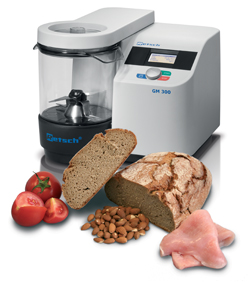Sample Preparation for Pesticide Residue Analysis using the QuEChERS Method
In food or nutritional laboratories, in chemical or biological research institutes—homogeneous sample material is required everywhere for the accurate analysis of food and feed materials. The diversity of foodstuffs with their often very different product properties represents a challenge for food testing laboratories.
Before the actual analysis, the food sample—which can vary strongly with regards to hardness and moisture—needs to be homogenized and reduced to a sufficiently small particle size. Retsch’s GRINDOMIX knife mills are the ideal tools to meet the complex requirements of sample preparation of food. The model GM 200 has proven itself for the homogenization of smaller sample volumes of up to 700 ml. For larger volumes, Retsch now offers the new GRINDOMIX GM 300 with a grinding chamber volume of 5,000 ml.
Both mills are ideally suited to homogenize substances with a high water, oil or fat content as well as dry, soft, medium-hard and fibrous products. They are often used for the sample homogenization as part of the so-called QuEChERS method (quick, easy, cheap, effective, rugged and safe) which was developed by Michelangelo Anastassiades (Chemical and Veterinary Investigation Office CVUA, Stuttgart, Germany) to make sample preparation to pesticide residue analysis more efficient. The method basically consists of three steps: homogenization, extraction and analysis. Test series have proved that the analysis results obtained with the QuEChERS method can easily compare with more common methods, such as DFG S19. During the homogenization process, care must be taken that the sample does not get too warm, as some pesticides are volatile. Therefore, it is recommendable to cool the sample which also improves the breaking behavior of the material thus achieving a higher fineness and homogeneity. For this purpose, a special lid was developed for the GM 300 to be used when grinding samples mixed with dry ice. An alternative option is the Retsch CryoMill, which continually cools the sample with liquid nitrogen.
 After the homogenization, 10 g of the food sample are extracted with 10 ml acetonitrile. As the next step, the organic phase is dried and tested for pesticides with chromatographic analysis. To avoid ghost peaks in the chromatograms, the sample is extracted in the presence of a salt mixture (e.g., sodium chloride and magnesium sulfate in a 1:2 ratio). This mixture can be easily obtained by using a professional sample divider like Retsch’s PT 100. With this rotating divider, the salts are reproducibly mixed so that the composition of each fraction is identical. In this way, up to 10 salt mixtures can be obtained in reproducible quality. To transfer the pesticides from the sample into the organic phase, the mixture is agitated for 1 to 3 minutes with the acetonitrile and salt. The mixture can be agitated by a laboratory mill such as Retsch’s Mixer Mill MM 400. It moves the sample in a 50-mL Falcon tube with a frequency of up to 30 Hz thus ensuring thorough mixing of the sample, which is beneficial for the subsequent extraction.
After the homogenization, 10 g of the food sample are extracted with 10 ml acetonitrile. As the next step, the organic phase is dried and tested for pesticides with chromatographic analysis. To avoid ghost peaks in the chromatograms, the sample is extracted in the presence of a salt mixture (e.g., sodium chloride and magnesium sulfate in a 1:2 ratio). This mixture can be easily obtained by using a professional sample divider like Retsch’s PT 100. With this rotating divider, the salts are reproducibly mixed so that the composition of each fraction is identical. In this way, up to 10 salt mixtures can be obtained in reproducible quality. To transfer the pesticides from the sample into the organic phase, the mixture is agitated for 1 to 3 minutes with the acetonitrile and salt. The mixture can be agitated by a laboratory mill such as Retsch’s Mixer Mill MM 400. It moves the sample in a 50-mL Falcon tube with a frequency of up to 30 Hz thus ensuring thorough mixing of the sample, which is beneficial for the subsequent extraction.
Preparing Foodstuff in a Contract Laboratory
The Italian contract laboratory pH s.r.l. is equipped with a variety of sample preparation and analysis tools including some mills and one high-speed ultra centrifugal mill. pH Lab is involved in food and feed analysis for many of the major Italian food producers. The neutral-to-analysis preparation of food samples is of crucial importance, especially for the detection of mycotoxins and pesticides. For this type of analysis, it is mandatory to obtain a fully homogenized sample and to avoid sample heating to preserve the volatile components. pH Lab tries to keep the sample preparation process as efficient as possible. With an average workload of 15 to 20 samples per day, time saving is an important issue. They frequently process vegetable and fruit samples.
For smaller volumes, they use the Knife Mill, but if larger quantities need to be homogenized, the bigger GM 300 provides the best results, as it allows for processing of up to 4,500 ml sample material. With the GM 300, they are able, for example, to process up to eight bananas in one shot, without pre-cutting the sample. Using the patented gravity lid, which dynamically reduces the volume of the grinding chamber, they are able to obtain a perfectly homogenized result. After the sample preparation, they add the QuEChERS reactive solution to examine pesticide contamination. Depending on the sample properties, they sometimes mix it with dry ice (ratio 2:1) to improve the breaking behavior, using the stainless steel container. Manuele Mecacci of pH Lab is convinced of the benefits of the GM 300: “We are fully satisfied with the performance of the new RETSCH GM 300 equipped with the gravity lid! To obtain such a high degree of homogenization was impossible with the equipment we used before. Moreover, the GM 300 helps us to save time as it processes most samples within seconds.”
For more information, contact Kyle James, vice president of sales for Retsch Inc. at 267.757.0351 or kyle.james@retsch-us.com.
Looking for quick answers on food safety topics?
Try Ask FSM, our new smart AI search tool.
Ask FSM →






